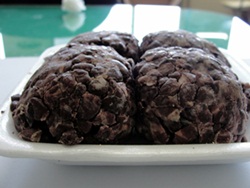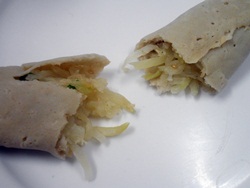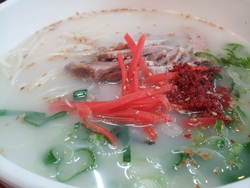
Omegitteok is a round shape rice cake based on a glutinous millet dough mixed with mugwort and an adzuki bean paste inside, covered with sweetened boiled adzuki beans. In Jeju Island, the volcanic island where it has been hard to cultivate rice plants, glutinous millet has been a garden-variety plant, and Omegitteok is one of Tteoks made of glutinous millets. Glutinous millet powder is mainly used with additional mugwort, whole red beans, and glutinous rice flour to make Omegitteok.
It is uncertain where the definite meaning of the word “Omegi” came from, but a claim that Omegi means glutinous millets is strong. The Omegitteok is easily seen during Fall when glutinous millets are harvested a lot. When Omegitteok is covered with yeast powders and placed in a jar, it turns into Omegi alcohol. Omegitteok can be often found in traditional markets or tteok stores in Jeju Island.
By Woo Hyo-Seung

Have you ever tasted Jeju's traditional food, ‘Bing-ddeok'? You might think of general rice cake from the word 'ddeok'. However, you can often find it in traditional markets rather than in normal rice-cake shops. It is made by rolling the dough 'bing bing' (into a ball). , julienne radishes are added into the dough which is made by buckwheat flour. Along with seasoned radishes, small green onions are also added. When having tasted the Bingddeok, many can’t feel the strong flavors like sweetness or spiciness. But people fall into that tasteless flavor of the Bingddeok.
Until the 1970's, the Bingddeok was used as traditional rites' food in Jeju. However, as the economy improved, that culture has disappeared automatically. It is now welcomed as a new diet food because of its low calories and long-lasting satiety. Also, its main ingredient 'buckwheat' is well known a healthy food. It energizes the body with enforcing the five viscera. Moreover it contains 'rutin' which reinforces blood vessels' resistance.
There are many ways to diversify its form by incorporating the traditional and modern cooking style. For example, we can change the color of buckwheat dough and we can change the radishes into other specialties in Jeju like horse or black pig meat. Try to feel our food culture with soft and delicate seasoning. You will be falling into this soft attraction.
By Kim Gyu-Jeong

We call Mom Soup Mojaban Soup in standard language. It is Jeju’s traditional food that cook pork soup with gulfweed, sour kimchi and dried radish greens. It has its own unique thick and deep taste which tart kimchi and gulfweed come together instead of greasy pork soup flavor. Jeju people ate Mom Soup since it helps people feel satiated and keep fit when they had nothing to eat. We can find similarity between Jeju and Okinawa longevity village in Japan in eating pork and seaweed together.
One way to cook Mom Soup is make pork broth and then put gulfweed, kimchi and sea mustard. Then put buckwheat flour into boiling pork broth and stir well. Some add pork guts or clotted blood from cows and pigs.
By Kim Ji-Gyeong

There are sadness and happiness in the noodles. In Jeju Island, when people have a wedding or funeral rites, they serve guests with "go-gi-guk-su" that is made by pork broth and noodles.
In Jeju Island, if people say 'meat', then it usually means pork rather than beef and chicken because, in the past, people use pork in all ceremonies. Pig is so special as it is used use not only in ancestral rituals but also in shamanism's rituals.
'Gogigooksu' is traditional food which one can feel past life and culture in Jeju Island. In the 1950s, after developing dried flour noodles, the present form of 'Gogigooksu' was completed. As suffering through the Japanese colonial period and Korean War, lots of traditional food of Jeju Island disappeared.the noodles shined through a policy encouraging meld grain diet which Park Jeong-Hee (the ninth president of Korea) executed.
'Gogigooksu' is well-being food because the noodles are made with the least seasoning so we can taste the flavor of ingredients themselves. Especially in the noodles they use black pork which grows in Jeju Island. And black pork is famous for its good taste more than normal pork.
The noodle is suitable for foreigners who can't eat spicy food. In Jeju Island, most of restaurants sell 'gogigooksu'.
By Kang Yun-Jung

